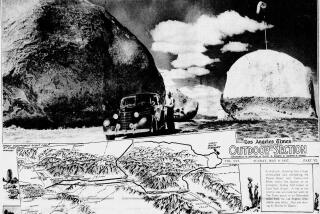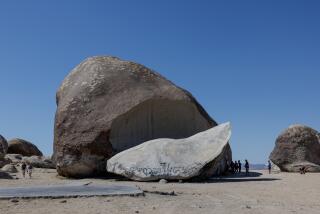It’s No Rock of Gibraltar--but, Indeed, a Rare Treasure
- Share via
We have acquired a new object to go with the tons of useless impedimenta that now lie around our swimming pool waiting to be stuffed back into the garage when our remodeling project is finished.
It is a 60-pound rock. It is, of course, not just any rock. It is one of thousands of similar rocks dredged out of the earth at 6th and Flower, in 1969, during the excavation for Arco Plaza.
It is about 14 inches long and 8 inches high. I can attest that it weighs 60 pounds. When my wife carried it in from her car, she was obviously struggling more than she does with our 40-pound sacks of dog food. She set it down on the patio above the pool. I tried to lift it and decided I’d better not.
It looks like a chunk of hardened gray sludge, except that its surface is covered with fossils--the whitened outlines of mollusks, snails and crustaceans. These life forms are said to be 7 million to 8 million years old. So at that time, evidently, downtown Los Angeles was under the sea.
We are indebted for the rock to our friend John D. Weaver, who discovered this geological treasure back in 1970 and wrote an article on it for The Times’ West magazine. Weaver at that time evidently was given several rocks from the dig as souvenirs, and earmarked one for us.
In his article, Weaver explained what had happened. It was the eve of the Ice Age. The Los Angeles basin was under the ocean. Prehistoric snails and clams had an easy life in the warm shallow water, feeding on algae, plankton and one another.
“Then,” Weaver wrote, “an earthquake or a violent storm seems to have triggered a subterranean landslide. Along with cobbles and a good part of the shell bed below them, the mollusks flowed down the ancient sea bottom four or five miles south toward what is today the downtown area and ended up in some 2,000 feet of cold water at the corner of Sixth and Flower.”
Weaver quoted a paleontologist who explained that the change from warm to cold water caused lime to be precipitated, and it cemented the rocks and shellfish in a matrix.
The paleontologist, Manley L. Natland, called the rock “mudstone,” and said that it contained hundreds of thousands of little marine shells to the square foot.
That means, of course, that our rock contains hundreds of thousands of marine fossils; it is part of the history of Los Angeles, and, in fact, may presage the fate to which we are yet doomed.
My problem is what to do with it. When Weaver first told me he had saved a rock for me I was less than enthusiastic. I really didn’t want another rock, no matter how important it might be in a geological sense. My wife had already carried back hundreds of rocks from Baja, and I had never been able to work up much interest in them.
A year or so ago, Weaver, then a widower, remarried and moved from Encino to North Carolina. I hoped that was the end of the rock. But we received a phone call from a mutual friend, Jack Beck, saying that Weaver had left the rock for us in his care, and what did we want to do about it. I told him to hang on to it--we’d think of something.
The other day we received a letter from Beck. “I recall talking briefly to you on the phone at the time,” he said, “and sensing that you were less than eager to take possession of the rock. Your subsequent laments about the state of your garage suggest the reason. . . . Still, the rock is here, awaiting your or Denise’s pleasure.”
I was overcome by a sense of guilt. John Weaver, a prince of a man, had set that rock aside for us, and we were rejecting it. Not only were we rejecting the overtures of a good friend, but also an extraordinary piece of geological history. We should be proud to have that rock in our garage.
I remembered, from Weaver’s article, that the paleontologist Natland had formed a company to exploit the mudstone by having it sliced into cocktail table tops. I thought that, at worst, we could do that. Or I could use it to cover my bar. But when Natland contracted with a marble cutting company to slice his stones, it ruined their diamond saw blades.
If Weaver happens to read this I hope he won’t be offended. I treasure the rock. I think we must all be reminded that we weren’t first on Earth; that other species have vanished, and we will too.
However, I have the feeling that the rock will survive my wife and me. I can see our sons kicking through the junk in the garage and coming upon the rock.
One will say, “What does that look like to you?”
And the other will say, “Looks like a rock.”
They will conclude, of course, that it must have been important to us, and it will end up in one of their garages.
More to Read
Sign up for Essential California
The most important California stories and recommendations in your inbox every morning.
You may occasionally receive promotional content from the Los Angeles Times.













